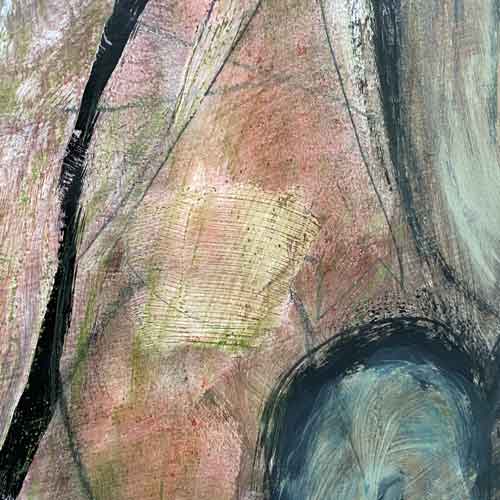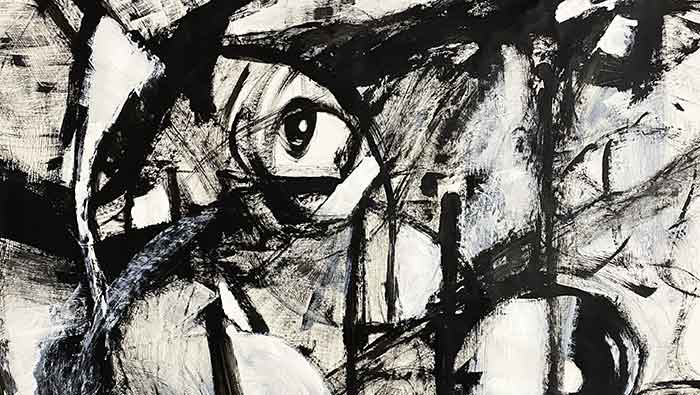If you follow me on Instagram you may have noticed a change in my work. I’ve been creating large black and white (cream actually) drawing exercises on paper. The specific exercises come from Steven Aimone’s book Expressive Drawing. It’s a great book. My friend Marie sent me a copy and I’d recommend it to anyone at any level.
While the exercises are terrific, I think the important thing was that I embraced them wholeheartedly and I worked on them without expectation. I had no idea what I’d learn or discover. I didn’t care if I had a finished product. They were pinned roughly to a wall and then thrown on the floor. I stood on them occasionally. The paper buckled from the weight of paint. I kept going.
I worked on these exercises obsessively, as if something was at stake. I guess desperation makes a good student.
Desperation…then an opening
I started a few paintings at the end of last year and I wasn’t excited by them. They had some beautiful passages, the colour was working well, but they lacked conviction. In fact, they struck me as insincere. I’d never felt that way about my paintings before and it was a shock. I wasn’t sure what to do. The exercises felt like a way forward, an opening…so I dove in.
My phone filled up with photographs of drawings in progress (seeing the entire painting on a small screen can be very revealing). Black charcoal dusted the baseboards in my studio, and the brush I used for white paint grew horns from resting in a messy pot and never getting washed. One corner of my studio filled up with rolled paper—the fresh stuff, and rumpled rolls of finished exercises.

Drawing and veiling exercise

Horned paint brush

Soft pastel over paint
Working on a large(ish) scale
These pieces are fairly large—roughly 42” square. I start them with compressed charcoal, black paint, pencil, then cover up some of these marks to edit or create new shapes of negative space.
I like the size. The paper is big enough that I have to move my shoulder to make a big mark, but it fits on a free wall in my studio and I can walk around them when they’re on the floor. When I work smaller the marks are less physical and they start to look stiff and forced. It’s fascinating how scale affects my marks. I like to have at least two on the go at the same time so the paint on one can dry while I work on another one.
Adding colour, investigating substrates
Lately I’ve been experimenting with adding colour and seeing if some of the drawings could be taken further. I tried a few different things, but soft chalk pastels are working well. I can make sharp thin lines, thick swoops, pale washes and they blend easily under a finger or a wet brush. I’m experimenting with fixative and/or gloss medium to keep the pastels and charcoal in place. Sometimes I let them blur together and explore the line between control and accident. I’ve also begun to try this way of working on stretched canvases I had. I might try unstretched canvas next. I try to stay open and not rush to conclusions.
Trying new things
Sometimes it feels like I’m bouncing around too much as an artist. I’m an acrylic landscape painter, ooh let’s try oils, now I’m all into expressive line and soft pastels. And let’s not forget my fascination with oil pastels. Today I’m picking up a used plein air easel so I can paint in the woods, or maybe just the backyard.
On occasion I’ve worried about it—feeling I should focus on something and persist. But I think it’s necessary. It’s typical of newer artists, but for some restlessness is a key aspect of their creative practice.
Lately I’m feeling that all this exploration is important and less random than it might appear. Something is emerging. I’m figuring out what I like and what I don’t. I’m starting to see patterns in my interests and connections between paintings that appear unrelated. I’m going somewhere…
No shows this year?
All this work might lead to finished pieces or it might not. I didn’t apply to any shows or fairs this year. If at any point I have a little group of work I’m happy with, I’ll let you know (subscribers first, as always). Until then, I’ll just keep experimenting and prioritizing process over everything else.
Usually I perform well with a deadline. With painting I need to feel as free as possible with no pressure or need to finish. This may change as I become more experienced. Or I may need to find a way to schedule things so that shows and unpressured experimentation can coexist somehow.
But these are problems for another time. Right now I’m painting, freely, with no expectations. Expectations creep in, absolutely, but I do my best to banish them, or at least keep them at bay. I’m excited to see what emerges.
If you’d like to see more of these drawings and other experiments, I post works in progress and finished exercises on my Instagram account either as posts or in my Stories.
Stay in touch
Sign up for first access to new work
(and never miss a blog post)

Lindsay, I appreciate your eloquent writing! I cannot wait to see what emerges from your exploration. I know there are artists who feel that specialization is the way to go, but I am not convinced. The mantra in education in recent years has been to help students develop into “lifelong learners.” I believe artists should be lifelong-explorers; yours is certainly looking great!
Thanks for reading Marie! I think there’s something to be said for doing a deep dive into something too. Maybe an exploration will lead to something I work with for a long time, or maybe I’m going to keep making radical turns in my work. I’m trying to be open to all possibilities, and be ok with not knowing.